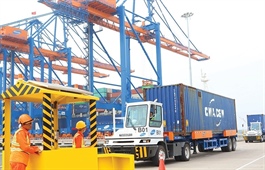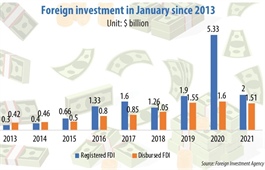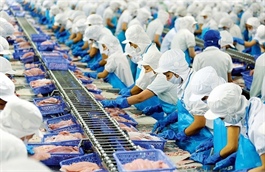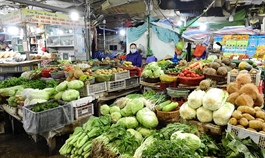Enacting long-term reforms for strong economic recovery
Enacting long-term reforms for strong economic recovery
As the global economy is still mostly struggling with the health crisis, the start in 2021 is overshadowed by the hurdles of the previous year. Nevertheless, Vietnam may regain traction in economic growth. Assoc. Prof. Dr. Pham The Anh, chief economist from the Institute for Economic and Policy Research under Hanoi National University’s Economics University looks back on 2020 and gives an outlook for the new year.

Assoc. Prof. Dr. Pham The Anh, chief economist from the Institute for Economic and Policy Research under Hanoi National University’s Economics University
|
Amid the global economic downturn and uncertainties, the Vietnamese economy – though not unscathed by the pandemic – is one of the few bright spots in the world as it achieved a GDP growth rate of 2.91 per cent, according to the General Statistics Office (GSO). However, the figure may not reflect all difficulties as the informal sector was heavily influenced by social distancing measures which are not reflected in the statistics.
In 2020, the total number of enterprises that suspended their operations reached 101,700 – a sharp increase of 13.9 per cent over the previous year.
In contrast, the number of newly-established enterprises or those who resumed operation was 179,000, a slight increase of 0.8 per cent compared to 2019. A survey by the GSO shows that, although the majority of the surveyed enterprises expected a better economic outlook in the second half of 2020 and early 2021, the number of pessimistic responses remained large. This partly reflects the current difficulties and uncertainties of the domestic and global economies in the face of the pandemic, which still delays investment in domestic production.
By the end of December, the state budget revenue was estimated at nearly VND1.46 quadrillion ($63.47 billion), with a deficit of about VND55 trillion ($2.39 billion, 3.65 per cent of the estimate), decreasing steadily from both domestic revenue and import-export activities. Although the budget plan has not been finalised, the figures are encouraging amid the pandemic.
In addition, the disbursement of construction capital was also relatively high compared to previous years, with accumulated public investment disbursement reaching VND455.21 trillion ($19.79 billion), up 67 per cent compared to 2019 and equalling 80.3 per cent of the plan for 2020, thus representing an important driver for the positive growth throughout the year.
The public debt to GDP ratio increased slightly from 55 per cent at the end of 2019 to 56.8 per cent by the end of 2020. However, this may decline severely, as the GDP calculation method is about to be adjusted in 2021. Nevertheless, that does not mean that the fiscal space has opened up significantly.
Public debt has been steadily growing faster than the state budget’s revenue in recent years, causing direct debt to reach the ceiling of 25 per cent of total state budget revenue by the end of 2020. That means that one-fourth of the state budget’s revenue is only enough to pay back annual interests, and this ratio is even expected to be higher soon. Thus, Vietnam’s fiscal situation is very limited as long as the pandemic continues.
Uneven growth
The State Bank of Vietnam (SBV) has had a busy year with three interest rate adjustments. As a result, the refinancing rate, the discount rate, and the short-term deposit cap fell from 6, 4, and 5.5 per cent at the beginning of the year to 4, 2.5, and 4 per cent, respectively, in the last months of the year.
Also, Circular No.01/2020/NHNN released last March on debt rescheduling and exemption to assist borrowers affected by COVID-19, now allows enterprises affected by the pandemic to reschedule repayment periods and enjoy exemption or reduced interests. Meanwhile, credit institutions whose customers are allowed to reschedule repayment terms can use provisions to deal with risks but do not have to apply the adjustment principle to the debt group with higher risk levels. Besides this, the SBV also issued Circular No.08/2020/TT-NHNN last August, delaying the schedule of reducing the maximum rates for short-term capital loans by one year.
Monetary expansion and the loosening of systematic safety regulations have helped businesses somewhat to access cheaper and easier credit. Moreover, the lower lending interest rates help commercial banks to cash in on interests. As of December 21, growth of total means of payment and credit growth reached 12.56 and 10.14 per cent, respectively. Meanwhile, the uncertain future causes investments in businesses to decrease, thus helping to save reserves and increasing credit institutions’ mobilisation sharply by 12.87 per cent, higher than in 2019.
As economic growth in 2020 was only one-third of the 7.02 per cent in 2019, it remains unclear what the final destination of the cash and credit flow could be. It is possible that part of credit growth came due to the rescheduling structure, as businesses have been encountering difficulties in paying on time.
In addition, a large amount of money has been absorbed by government bonds. According to statistics from the Hanoi Stock Exchange (HNX), the net amount of government bonds issued by the State Treasury in 2020 was about VND219 trillion ($9.5 billion), 2.6 times higher than in 2019, with the majority bought by credit institutions. Lastly, credit may not flow directly into production, but into consumption channels of imported goods and asset transactions.
Although consumer prices are quite stable, asset prices are a worrying risk as long as the monetary policy is loosened. The VN-Index increased 15 per cent compared to the beginning of the year, while the HNX-Index increased 98 per cent compared to the beginning of the year. On the last day of the year, the capitalisation of the Vietnamese stock market reached nearly VND5.3 quadrillion ($230.43 billion), an increase of nearly 21 per cent compared to a year ago.
Real estate prices also increased abnormally during the year, especially in places where large infrastructure projects had been deployed. According to the Vietnam Association of Realtors, land prices of many projects in the west of Hanoi, Bac Ninh, Bac Giang, and localities bordering Ho Chi Minh City all roughly doubled last year. Meanwhile, rents of industrial land peaked in both the north and the south.
The main beneficiaries from the expansionary monetary policy were mainly the banking and finance sector rather than manufacturing. This price bubble can not only destabilise the economy and slow down economic recovery but also increase the gap between the rich and the poor.
Economic outlook for 2021
The world’s economic outlook still depends on the ability to control the pandemic on a global scale, which is unlikely to happen within the next year. Economic growth in 2021 can be quite high, mainly due to a very low base of 2020, but economic activities cannot completely return to normal at least until the last months of the year. Policies to support growth and ensure social security are expected to continue, especially in developed countries. The International Monetary Fund and the Organisation for Economic Cooperation and Development estimate global GDP growth at 5.2 and 4.25 per cent, respectively, for 2021.
The driving force for Vietnam’s economic growth is forecast to continue to come from exports and public investment. With the continued inflow of foreign direct investment into Vietnam – albeit slower due to the impact of the pandemic – the region’s exports still play the most important role in economic growth for many years to come.
However, the growth rate of exports will depend heavily on the recovery of the world economy and exports of traditional goods, which have been heavily affected in the past year. Meanwhile, the contribution of public investment to growth will not be as high as in 2020 due to limited financial resources.
The total investment capital from the state budget in 2021 is expected to be over VND477 trillion ($20.7 billion), up 1.4 per cent compared to the investment plan in 2020.
As long as the pandemic remains uncontrolled and confidence does not return, it will be difficult for businesses to increase their investment, even if interest rates fall. Many service industries are not expected to recover in the coming year. Therefore, Vietnam’s economic growth may fluctuate between 4 and 6 per cent in 2021. Consumer prices are expected to continue increasing moderately because of multiple intertwining factors. First, the recovery of the world economy will cause the global demand and prices of raw materials to increase, likely over the 2020 average. Second, the appreciation of real estate and securities is likely to spill over into consumer prices, which may also increase people’s consumption, especially after the pandemic.
Maintaining the value of the VND against the USD will help Vietnam limit inflation. As the economy cannot return to normal so quickly, the income of the majority of the population will also be affected and increase only slowly or even decrease, making it difficult for demand and consumer prices to increase rapidly. If there are no agricultural disasters, consumer prices are expected to increase moderately at around 3-4 per cent in 2021.

























